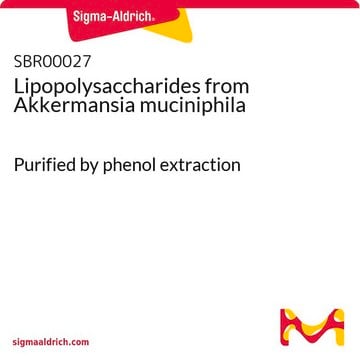SMB00801
Lipopolysaccharides from Proteus vulgaris
purified by phenol extraction
Synonym(e):
LPS
About This Item
Empfohlene Produkte
Biologische Quelle
bacterial (Proteus vulgaris)
Qualitätsniveau
Form
lyophilized powder
Aufgereinigt durch
phenol extraction
Verunreinigungen
≤3% Protein (Lowry)
Farbe
white to yellow cast
Löslichkeit
water: 4.90-5.10 mg/mL, faintly hazy to hazy, colorless to faintly yellow
Versandbedingung
ambient
Lagertemp.
2-8°C
Allgemeine Beschreibung
Proteus vulgaris is a rod-shaped Gram-negative, facultative anaerobe bacterium. It inhabits the intestinal tract of humans and animals and can be found in soil, water and feces. P. vulgaris is a member of the Enterobacteriaceae family which are opportunistic pathogens in humans, responsible for urinary tract and burn infections.
The chemical structures of LPS from Proteus sp. are different from each other.
Biochem./physiol. Wirkung
Sonstige Hinweise
Ähnliches Produkt
Lagerklassenschlüssel
11 - Combustible Solids
WGK
WGK 3
Flammpunkt (°F)
Not applicable
Flammpunkt (°C)
Not applicable
Analysenzertifikate (COA)
Suchen Sie nach Analysenzertifikate (COA), indem Sie die Lot-/Chargennummer des Produkts eingeben. Lot- und Chargennummern sind auf dem Produktetikett hinter den Wörtern ‘Lot’ oder ‘Batch’ (Lot oder Charge) zu finden.
Besitzen Sie dieses Produkt bereits?
In der Dokumentenbibliothek finden Sie die Dokumentation zu den Produkten, die Sie kürzlich erworben haben.
Artikel
Explore the structure, function, and diverse applications of Lipopolysaccharides. Discover their role in bacteria, serological specificity, and research potential.
Unser Team von Wissenschaftlern verfügt über Erfahrung in allen Forschungsbereichen einschließlich Life Science, Materialwissenschaften, chemischer Synthese, Chromatographie, Analytik und vielen mehr..
Setzen Sie sich mit dem technischen Dienst in Verbindung.



